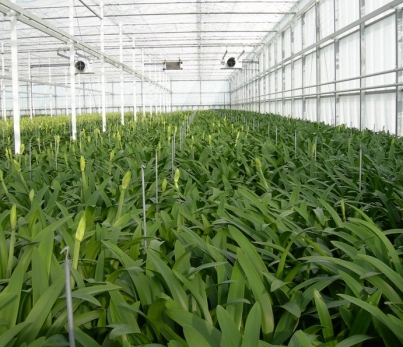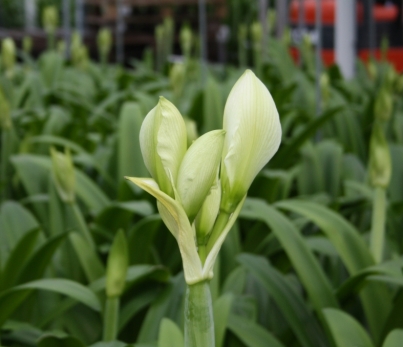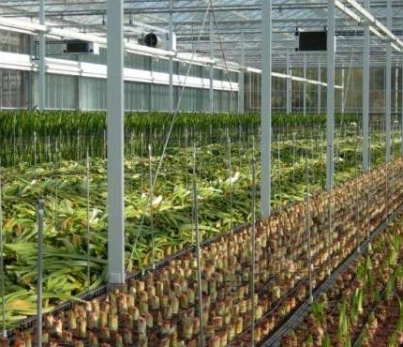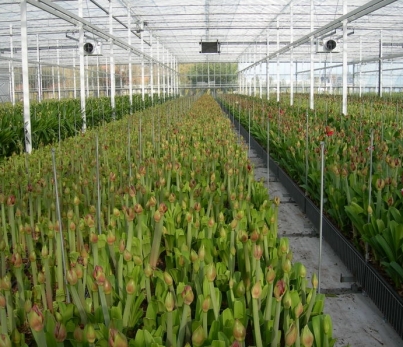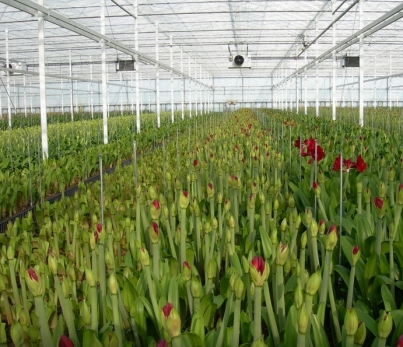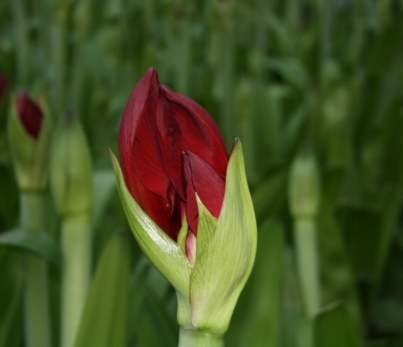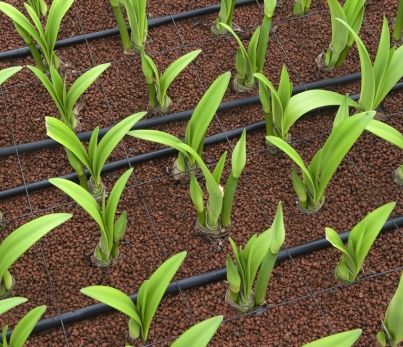Cultivation: growth, rest and blooming
Amaryllis is a bulb that blooms once a year. In nature, the crop and the bulbs grow in the summer, with new flower buds being created in the bulb. At the same time, the bulb stores a lot of spare food. This is necessary, because the crop dies after summer and the bulb with the new flower buds has to survive a cold period in the winter. When the temperature goes up in the spring, the flower buds appear and, thanks to the spare food in the bulb, grow into beautiful big flowers. When the flowers bloom, they are pollinated and as soon as the seed is finished growing, it can spread. In the mean time, new flower buds are growing inside the bulb, and that’s how nature repeats itself.
In the cultivation of cut amaryllis, these natural processes are used. By controlling the bulb- and greenhouse temperature we can spread the bloom and make sure that we can enjoy these beautiful flowers in the winter.
The following phases can be distinguished in greenhouse cultivation:
1. Growth phase: for a period of seven months, the bulbs grow under optimal circumstances. New leafs are continuously formed and the crop can grow up to 1,5 meters in size. During the period of leaf growth, two or three new flower buds are created per bulb. In this phase, the crop needs light, water, fertilizer and CO2.
2. Rest phase: the crop, the bulb in particular, requires a rest period of about ten weeks at 13°C, during which the rest of the flower buds is interrupted. In the greenhouse, the bulbs are refrigerated by cooling the soil through plastic tubes and a water temperature of 6°C. This way, the winter period is copied from nature. In the old days, the bulbs would be grubbed, placed in a refrigerator and then planted back again.
3. Bloom phase: after the rest period, the old leaves are removed. The bulbs will start blooming once they receive a sufficient amount of water and if the soil temperature is increased to 22°C. By controlling the soil temperature (cooling is rest, heat is growth), the bloom period can be scheduled and spread from September through March.
Amaryllis is a bulb that blooms once a year. In nature, the crop and the bulbs grow in the summer, with new flower buds being created in the bulb. At the same time, the bulb stores a lot of spare food. This is necessary, because the crop dies after summer and the bulb with the new flower buds has to survive a cold period in the winter. When the temperature goes up in the spring, the flower buds appear and, thanks to the spare food in the bulb, grow into beautiful big flowers. When the flowers bloom, they are pollinated and as soon as the seed is finished growing, it can spread. In the mean time, new flower buds are growing inside the bulb, and that’s how nature repeats itself.
In the cultivation of cut amaryllis, these natural processes are used. By controlling the bulb- and greenhouse temperature we can spread the bloom and make sure that we can enjoy these beautiful flowers in the winter.
The following phases can be distinguished in greenhouse cultivation:
1. Growth phase: for a period of seven months, the bulbs grow under optimal circumstances. New leafs are continuously formed and the crop can grow up to 1,5 meters in size. During the period of leaf growth, two or three new flower buds are created per bulb. In this phase, the crop needs light, water, fertilizer and CO2.
2. Rest phase: the crop, the bulb in particular, requires a rest period of about ten weeks at 13°C, during which the rest of the flower buds is interrupted. In the greenhouse, the bulbs are refrigerated by cooling the soil through plastic tubes and a water temperature of 6°C. This way, the winter period is copied from nature. In the old days, the bulbs would be grubbed, placed in a refrigerator and then planted back again.
3. Bloom phase: after the rest period, the old leaves are removed. The bulbs will start blooming once they receive a sufficient amount of water and if the soil temperature is increased to 22°C. By controlling the soil temperature (cooling is rest, heat is growth), the bloom period can be scheduled and spread from September through March.















